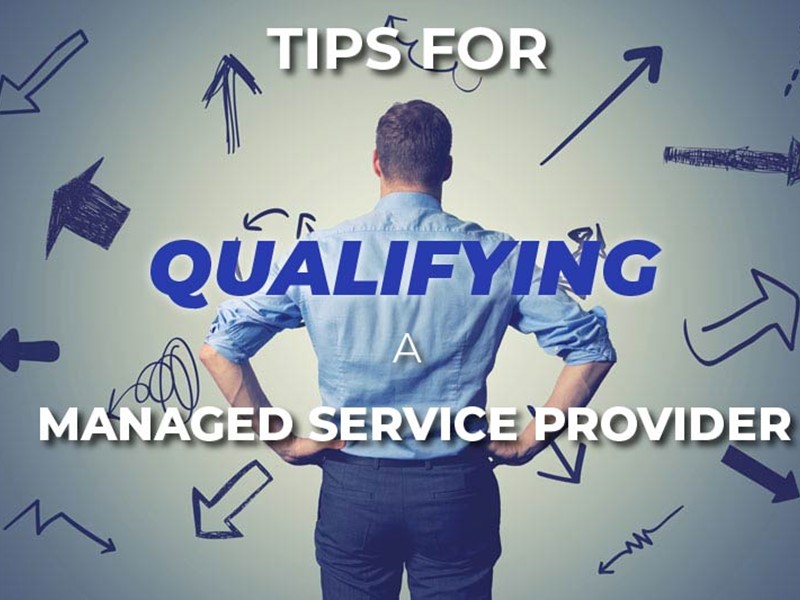Erin joined the SMIT Team in 2017. Her passion for technology and commitment to helping others inspired her career transition from Transportation Safety & Compliance to IT.
Tips for Qualifying a Managed Service Provider for Your Business

When businesses make the decision to outsource, it’s usually due to one of four reasons:
- Growth – they feel like their existing staff or provider cannot accommodate their growing business, and it would be costly to hire additional full-time staff
- Complexity – The time and expense for continuous training of existing staff doesn’t balance out.
- Unhappy with Current Provider – Their existing service provider is not a good fit
- Turnover & Retirement – IT employees accept another position, or have reached their much-deserving retirement
Before reaching out to a provider, it’s important to understand first and foremost your own organization’s core values and what a healthy partnership means to you. These criteria vary widely from one business to the next, including the providers you evaluate. Think of this process like you were hiring for a senior-level position. You likely wouldn’t hire an employee that wasn’t thoroughly qualified, verified, and had no understanding of your industry. Once a business decides on their managed service provider, they should emanate both expertise and experience.
The IT ecosystem is rapidly growing and evolving, causing traditional MSPs to expand their offerings to meet increasingly complex demands from their customers and prospects.
Managed service professionals are responsible for monitoring, guiding, and acting on behalf of multiple customers. If there isn’t evidence of in-depth knowledge and demonstrated experience with their technologies, why would prospective clients sign-on with them? It all comes down to making sure you are asking the right questions. While technology knowledge is important, it isn’t the end-all, be-all for selection. A healthy partnership requires dependability, trust, bringing meaningful contributions, understanding each other’s roles & responsibilities, and understanding points of contention from previous relationships.
Step 1:
Start by making a list of your pain points
This will allow you to ask specific questions about their ability to provide a better experience than what you’ve faced in the past. If the provider does not speak to this point confidently, answers indirectly, or cannot accommodate it, then make a note that they might not be a good fit for your organization and keep looking.
Step 2:
Due Diligence – Evaluate several providers
As a managed service provider, we expect our prospective clients have at least 2 other providers to compare against our service offerings and pricing. It makes for a better partnership when you choose the provider that aligns with your goals for the company vs. the one with the lowest bid.
Be sure to ask questions around your pain points. We frequently hear that a customer’s previous provider didn’t know their industry, or were slow to respond to their issues, so we made a list of questions that you should be asking each provider in your search:
-
“Are you experienced in my industry?”
Depending on the industry you’re in, you may have strict compliance mandates to adhere to, or nuances with legacy technology that is still required for your business operations. Choosing the right provider with experience in your industry will result in a more confident beginning to the partnership, not to mention improved productivity with faster ticket resolution times. Some industries are fairly similar to one another in terms of technology, so if they don’t have direct experience with yours, ask about their experience with similar industries.
-
“Do you invest in training and certification of your employees?”
Finding a provider that invests in their staff’s training and certifications shows that evolving with technology is important to them. One common thing we see while talking to prospective clients is that their current provider is advising them to use outdated technology, and the biggest problem with outdated technology is outdated security.
-
“Do you have a proactive methodology and incorporate technology alignment?”
Let’s start by explaining what technology alignment (TA) is and why it’s important. It’s the process of aligning your technology to today’s standards and best practices. TA checks evaluate the state of your infrastructure and if anything is found that could cause downtime/outages in the near future, they propose proactive solutions.
-
“Do you have responsive Service Level Agreements (SLAs)?”
Response time and resolution time are often points of contention in the service world. You will want to make sure that the SLA is included in their service offering and have a clear understanding of what those averages are.
-
“Are you scalable with my organization?”
Another common area of pain within businesses is that they outgrow their IT support, whether it’s outsourced to a one-man operation, consultant, or a functional role that an existing staff member added to their plate. You don’t want to re-evaluate a new provider every time your company has an influx of growth, or conversely, a provider that isn’t flexible in contractionary periods where you have to downsize. Asking this question will save you time and effort in the long run.
-
“What is your approach to cybersecurity?”
Start with some research on your industry and what the best cybersecurity practices are. If you are unsure of how you want to approach cybersecurity, asking this question to several providers can give you a list of services/solutions, and comparing the results across providers will likely result in some overlap of services. Take these back to your stakeholders to see what’s most important for your organization. You don’t want to pursue a provider that doesn’t have much to offer in this space.
Step 3:
Get References
References are an important part of the evaluation process. Think back to hiring for employees- they either list references on their resume, or provide them to you when prompted to attest to their work ethic and character. Same goes for any partnership that you are interested in pursuing, but especially valuable for an IT provider that will have such great influence on the daily operations of your business. A minimum of 2 references should be provided.
To ensure you have the right references, ask for customers with the following similarities:
- Industry
- Size / # of Users
- Comparable services to what you’re interested
Step 4:
Decision Made – Read the Fine Print
Once you’ve decided on a provider, be sure to understand the contract terms. You’re making a decision that can cause some minor or major disruption to your team, and it’s critical to understand ahead of time what your options are for terminating the contract if you find the company isn’t a good fit. Look for providers that offer reasonable outs for convenience. Ask if they charge contract termination fees, and if they do, what will those look like?
Summary
Being a managed service provider ourselves, these tips come from the experiences of our internal sales team. Prospective clients who have incorporated the above steps into their provider-vetting strategy make for confident, long-lasting partnerships.
1306 County Rd F West
Suite 200
Minneapolis, MN 55112
Service Desk: 612-788-9233
Sales: 612-999-6200
We're here to help
Ready to secure and streamline your IT?
Contact us today to see how we can help secure the future of your business.
